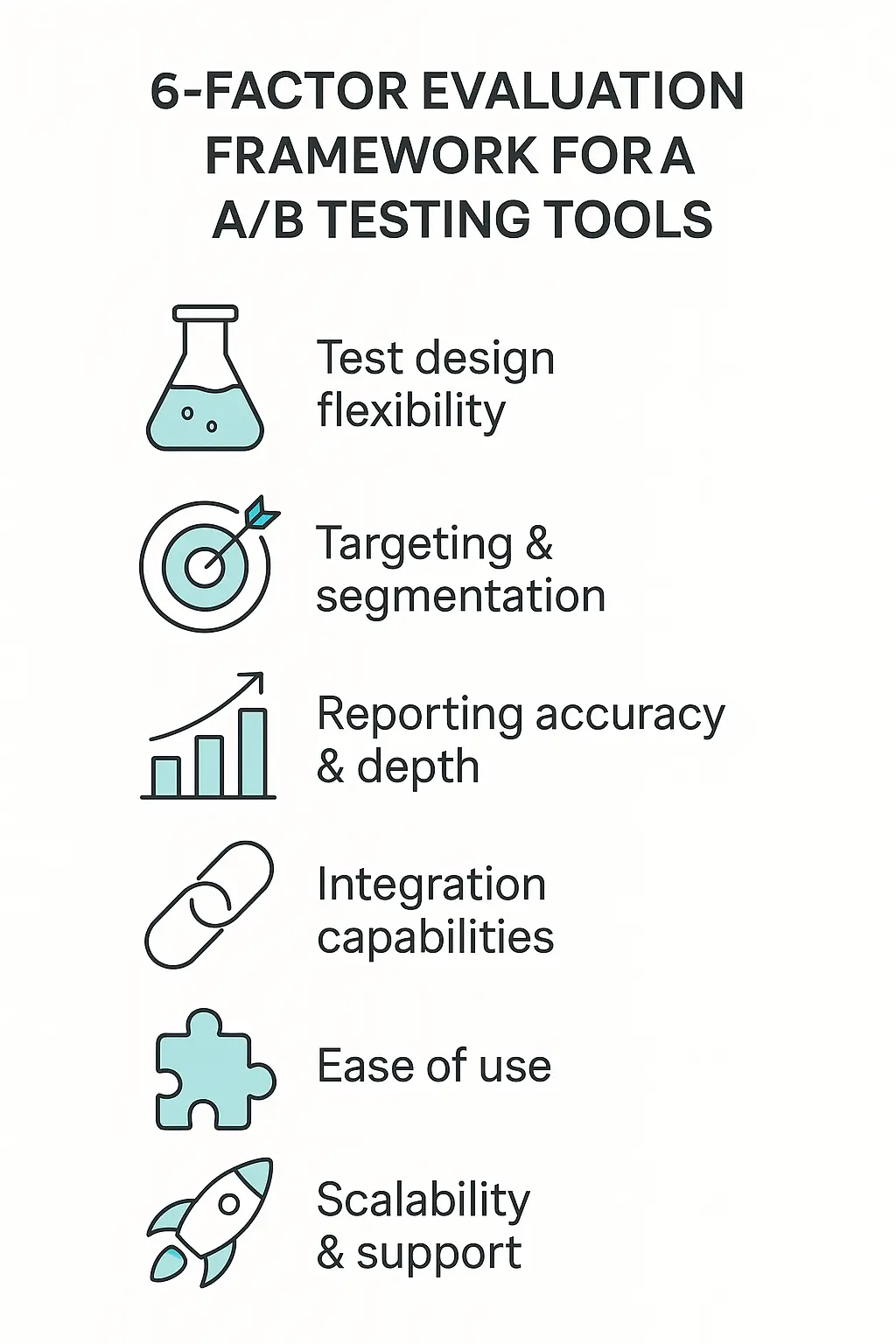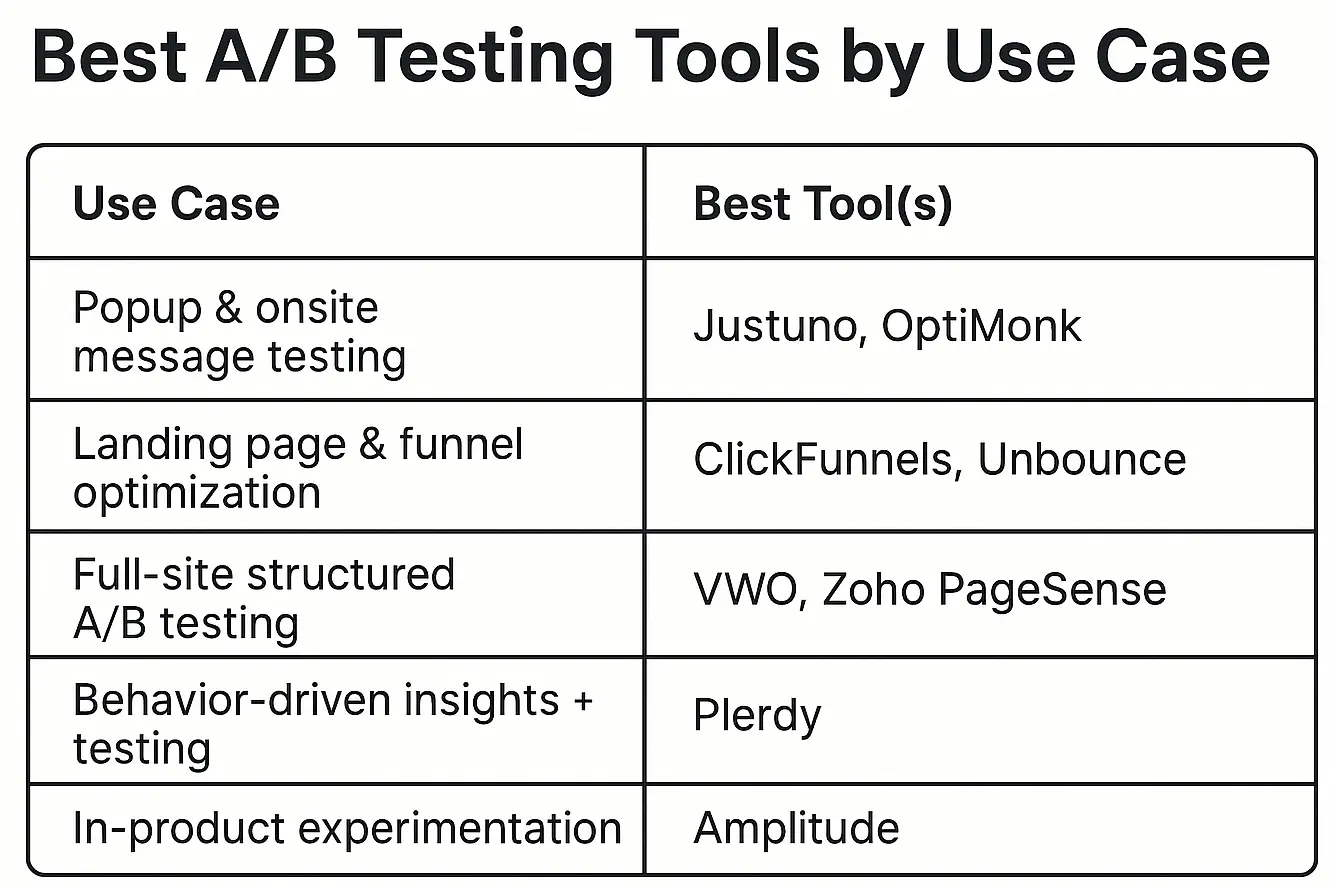We test and review software products using an independent, multipoint methodology. If you purchase something through our links, we may earn a commission. Read about our editorial process.
In digital marketing and product development, small changes can lead to massive gains—or costly losses. That’s why A/B testing has become a cornerstone of enhancing customer experience and understanding user behavior in social media, website optimization, and determining the right sample size for conversion rate optimization through data-driven decision-making, providing valuable insights. Whether you’re optimizing a landing page, refining your checkout flow, or testing email headlines, A/B testing gives you clarity over guesswork.
In 2025, A/B testing tools, including Google Optimize and AB Tasty, are more powerful and accessible than ever. They go beyond simple button color changes and now support multivariate experiments and AB testing with AI-generated variants, along with full-funnel impact tracking, including Google Analytics and other analytics tools, as well as your existing tech stack for improved insights. This guide explores the best A/B testing platforms, which are the best tools available today, selected based on reliability, feature depth, ease of use, and how well they integrate into real marketing workflows.
Modern websites, landing pages, and product interfaces are never truly “finished.” They’re constantly evolving to adapt to user preferences, platform changes, and business goals. A/B testing—also called split URL testing or split testing—allows you to present different variations of two or more versions of a web element or flow to your users, compare performance, and identify which version drives better results using statistical analysis based on A/B test results.
By running controlled experiments, businesses can:
Increase conversion rates without more traffic
Reduce bounce rates by aligning with user expectations
Improve engagement with better messaging or design
Make confident changes based on real data, not opinions
Continuously optimize campaigns and product experiences
But not all A/B testing tools are created equal. Some are built for marketers, others for developers. Some are tailored to CRO teams, while others serve entire growth organizations. Our selection below reflects that diversity.
To determine the best A/B testing tools of 2025, we applied our internal 6-factor framework:

Test design flexibility – Can the tool support multiple types of tests (A/B, split URL, multivariate)? Is the setup visual or code-based?
Targeting & segmentation – Can you show variants to specific user segments, traffic sources, or behavioral conditions?
Reporting accuracy & depth – Does it include statistical significance, confidence intervals, conversion paths, or trend graphs?
Integration capabilities – Does it connect to your CMS, analytics stack, ad platforms, or CRM?
Ease of use – Is the UI beginner-friendly? Can marketers or product teams launch tests without developer support while considering the learning curve?
Scalability & support – Is the platform reliable under high traffic? Does it provide onboarding, live support, or optimization tips?
Justuno is primarily known as a conversion optimization platform for eCommerce, but its built-in A/B testing tools make it easy to experiment with on-site popups, banners, and lead capture forms.
The A/B testing experience is visual and simple—perfect for marketers who want to test offers, headlines, or design changes on overlays without touching code. With Justuno, you can also layer in audience segmentation, showing different variants based on traffic source or behavior.
Best for: eCommerce marketers optimizing lead-gen popups and discount banners.
ClickFunnels is a popular funnel-building platform with a built-in A/B testing feature across its landing pages and sales funnels. You can clone a page, make edits to content or design, and distribute traffic between variants seamlessly.
ClickFunnels makes it easy to measure performance based on revenue, opt-ins, or custom goals. Although it’s more focused on funnel optimization than advanced statistics, it’s extremely useful for conversion-driven marketers.
Best for: Entrepreneurs and solopreneurs running direct-response funnels or lead-gen campaigns.
OptiMonk provides A/B testing within its personalization and conversion toolkit to enhance user engagement for different audiences. You can experiment with popups, messages, exit-intent offers, and embedded elements—without developer involvement.
It’s ideal for mid-size teams that want to test personalized offers or CTAs based on user segments. OptiMonk also offers AI recommendations for what to test, which helps newer CRO teams move faster.
Best for: Marketing teams running on-site personalization and dynamic messaging.
Plerdy is a CRO and UX analysis platform that includes heatmaps, user recordings, SEO tools, and A/B testing. Its testing module allows you to edit text, images, or CTA buttons directly on a live website using a visual editor.
Plerdy stands out for combining qualitative (behavioral data) and quantitative (conversion data) insight in a single tool. It’s also privacy-compliant and easy to implement, making it great for teams in regulated markets.
Best for: UX and CRO teams needing visual testing plus behavior analytics.
Amplitude is best known for product analytics, but its Experiment module enables statistically rigorous testing for product features, feature flags, feature management flows, and user experiences.
Amplitude supports holdout groups, user segmentation, goal tracking, and feature flagging. It’s ideal for product teams testing onboarding, paywalls, or in-app journeys where data accuracy and user cohort analysis are critical.
Best for: Product-led teams running experiments inside digital products or apps.
VWO is one of the most mature platforms in the A/B testing space, offering various pricing plans including a free plan and free trial. It supports visual A/B tests, split URL tests, multivariate tests, and behavioral targeting along with features like visual website optimizer tools for creating diverse web pages and mobile app experiences. It also includes heatmaps, surveys, and recordings to support qualitative insight.
With built-in statistical models and test significance reports, VWO helps teams move from idea to optimization confidently. It’s especially useful for larger teams working across marketing, design, and product departments.
Best for: Enterprises and mid-sized businesses with robust experimentation roadmaps.
Unbounce is a landing page builder with advanced A/B testing baked in. It lets marketers duplicate pages, change design or copy, and route traffic across variants automatically. Its Smart Traffic feature uses AI to dynamically send visitors to the best-performing version, highlighting its key features and key performance indicators.
You don’t need to know code or analytics theory to run meaningful tests. Unbounce is focused on fast execution and real-world conversion results—perfect for growth teams moving quickly.
Best for: Startups and agencies focused on high-converting landing pages.
Zoho PageSense combines A/B testing, personalization, heatmaps, and funnel tracking in a clean interface that integrates well with other Zoho products. Its A/B testing tool supports simple and multivariate testing, with qualitative tools for visual editing and custom goal tracking, providing deeper insights for users.
You can also target variations based on geography, referral source, or device type. With built-in reporting and a drag-and-drop editor, PageSense works well for marketers without a tech team.
Best for: Businesses already using Zoho or those looking for an affordable all-in-one CRO tool.
A/B testing isn’t just a growth hack—it’s a long-term strategy for improving user experience, reducing waste, and increasing revenue. The best A/B testing tools don’t just show you what’s winning; they empower your entire team to test smarter, learn faster, and launch with confidence.

To recap:
Choose Justuno or OptiMonk if you want to optimize popups and onsite messaging.
Use ClickFunnels or Unbounce if landing pages and funnels are your primary battleground.
Opt for VWO or Zoho PageSense for structured, flexible A/B testing across entire websites.
Select Plerdy if you need behavioral context like heatmaps and scroll tracking.
Go with Amplitude if your experiments are happening deep inside digital products or apps.
No matter your size or niche, the ability to test ideas with confidence is the hallmark of a modern, successful digital team.
The duration of A/B testing depends on the amount of traffic on your site and the goals of the test.
Typically, you should run the test for at least one full business cycle (e.g., one week or one month) to account for all possible variations in user behavior.
It is important to make sure that the sample of users is large enough to achieve statistical significance of the results. Use special calculators to determine the required sample size and duration of testing.
One of the main mistakes is not defining the goals of testing before starting it. Clearly state what exactly you want to improve and what indicators will be affected by the changes.
Another common mistake is running tests on too small a sample, which can lead to unreliable results. Make sure you have enough traffic to achieve statistical significance.
Finally, don't modify the test while it's running, as this can affect the results. Always complete the test according to the predefined plan and only then analyze the results.